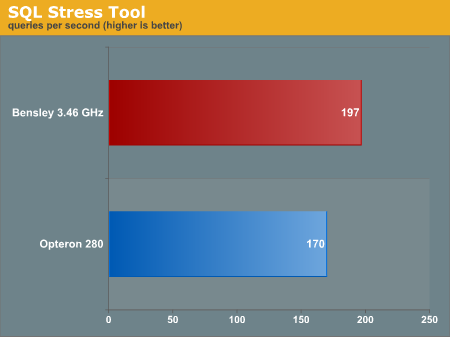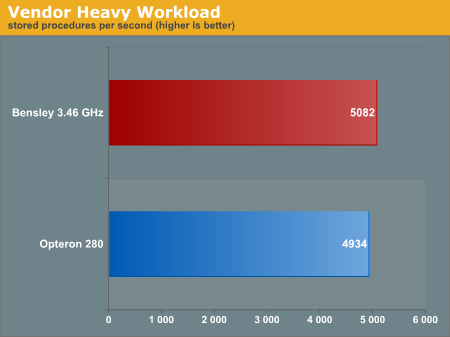Intel’s Dual-Core Xeon First Look
by Jason Clark & Ross Whitehead on December 16, 2005 12:05 AM EST- Posted in
- IT Computing
SQL Stress Tool Results(test description)
Intel’s pre-production Bensley system came out on top in this test, with a 14% lead over the Opteron 280 system. The 1066MHz front-side bus, no doubt, was required to achieve this result, along with the 2MB of L2 cache. Intel has always been competitive with AMD in this test, but was able to pick up an additional 4% this time around over their usual 10% lead.
This enterprise test has been of great interest to a lot of people, including Intel. Opteron has constantly dominated this test, but times have changed. Bensley essentially tied with the Opteron 280 in this test, as the difference was about 3% (which is standard deviation). The new Blackford chipset architecture, increased front-side bus and memory bandwidth all played a part in Bensley showing this kind of improvement. Where Opteron used to show, on average, a 15% gain over Intel, they are now neck and neck.
Intel’s pre-production Bensley system came out on top in this test, with a 14% lead over the Opteron 280 system. The 1066MHz front-side bus, no doubt, was required to achieve this result, along with the 2MB of L2 cache. Intel has always been competitive with AMD in this test, but was able to pick up an additional 4% this time around over their usual 10% lead.

This enterprise test has been of great interest to a lot of people, including Intel. Opteron has constantly dominated this test, but times have changed. Bensley essentially tied with the Opteron 280 in this test, as the difference was about 3% (which is standard deviation). The new Blackford chipset architecture, increased front-side bus and memory bandwidth all played a part in Bensley showing this kind of improvement. Where Opteron used to show, on average, a 15% gain over Intel, they are now neck and neck.











67 Comments
View All Comments
Viditor - Friday, December 16, 2005 - link
LOL...good answer! (especially from coldpower)Viditor - Friday, December 16, 2005 - link
BTW...you do know (I assume) that they don't use heaters in a data center, right? (I figured you did, but thought I'd check just to be sure...)JarredWalton - Friday, December 16, 2005 - link
Not entirely true. They use "environmental regulators" that keep humidity and temperature in a set range. In the winter, the AC portion does less, but the fans are still going full blast. I should know, as I'm sitting here listening to the 75 dB hum of a large regulator right now. :|Viditor - Friday, December 16, 2005 - link
That's my world as well...(TV broadcast equipment is kept under the same conditions...) so you have my condolences. But the point I was trying to get across was that the AC never gets turned off when it's a nice day outside...:)
coldpower27 - Friday, December 16, 2005 - link
Finally if we assume 40 Centers for 1 Year.$587.85 for 365.25 Days for 1 Bensley System.
$23,514 Total to Run 40 Systems for 1 Year.
Poser - Friday, December 16, 2005 - link
In addition to the math being off, the assumption that a datacenter would be paying a similar kW/h rate as a residential customer also seems suspicious. As a major customer, they couldn't negotiate a much better rate?coldpower27 - Friday, December 16, 2005 - link
Watt is Joule/Second isn't though??